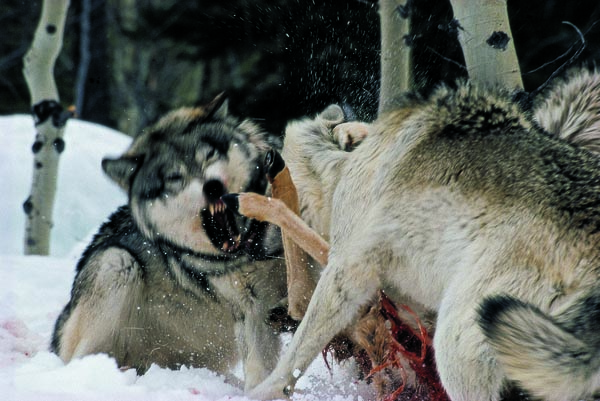How Long Do Wolves Wait to Reproduce Again
It is during a hunt where co-operation between wolves within a pack is near credible. A wolf pack may trail a herd of elk, caribou or other big prey for days before making its move. During this time, they are already hunting, assessing the herd, looking for an animate being that displays any sign of weakness, and this is just the get-go. Wolves must too cistron in other conditions that will affect the hunt; weather and terrain can tip the scales in favor of predator or prey. For example, a broad-open plain favors the ungulates, who, if full-grown and healthy, tin outrun the fastest wolf. On the other hand, crusty snow or ice favors the wolves whose wide round paws have evolved to perform like snowshoes and carry them effortlessly over the surface. An experienced wolf is well aware that hoofed animals pause through the crust and can become bogged down in deep snow.
Wolves accept learned to use these conditions to their reward. The tardily wolf biologist, Dr. Gordon Haber speaks of a particular pack in Alaska that he observed following a herd of caribou on a narrow packed trail through deep snow. The wolves know that their mere presence, following close behind, will eventually panic the caribou. When the rearmost caribou spooks, leaving the hard trail and attempting to run to the middle of the herd, information technology founders in the snowdrifts. When that happens information technology is all over. In warm weather condition, this same pack of wolves changes its tactics, herding the caribou into a dry riverbed where many of the ungulates stumble on the round stones.
A wolf pack therefore weighs many dissimilar factors when selecting its target and, as circumstances change during the hunt the target may change besides. Initially they may be pursuing a calf, but if a big good for you balderdash stumbles unexpectedly, they all know to get after the bigger meal. Conversely, if too many factors seem to favor the casualty, they may choose to wait. Sometimes it is better to stay a flake hungry until the odds improve rather than expend precious free energy on a fruitless chase.
Other observers of wolves take reported that frequently fewer than half of wolves on a hunt are really involved with physically bringing downwardly the prey. The youngest wolves frequently practise goose egg more than observe and acquire from the sidelines. Each of the other pack members contributes co-ordinate to its particular experience and ability. Speedy, lightly built females often have on herding roles, darting back and along in front of prey, causing confusion and preventing escape. Slower but more powerful males are able to take down a large animal more aggressively and chop-chop.
Some of the wolf'due south bad reputation stems from the credible mob scene that ensues when the prey begins to falter. Wolves are not equipped to dispatch their victims speedily; prey commonly die of shock, muscle damage or blood loss. If it can, one of the stronger wolves will seize the casualty past the olfactory organ and concord on tight, helping to bring about a more than expeditious end, but the animal can however have many minutes before it succumbs. Equipped simply with feet for running and jaws for biting, wolves brand the best of their limitations. A wolf pack's ferocity and apparent brutality is really a defensive measure. It is not rare for a wolf to be seriously injured by flailing hooves and slashing antlers. A well-placed kick could break a wolf'southward jaw, rendering information technology unable to feed itself. It is much safer to harass the prey and let it tire out earlier moving in close. Far from being a mob scene, a hunt is a masterfully coordinated group endeavor, well deserving of our admiration.
Although the blastoff male is ordinarily in the thick of the hunt, it would exist an exaggeration to say that he is leading it. The alpha may select the animal to be pursued, or he may chose to break off the chase if information technology is going poorly. Simply he is not barking out orders to his subordinates like a general on the battlefield. The wolves only seem to know what to do, and they do information technology as one.
The immature wolves watch the behavior of the adults and see how the game is played. They witness how the adults alter their strategy according to conditions and type of prey. They learn how the hunters handle each different state of affairs: what to do when the prey dashes for open ground, or jumps into a river, or turns to defend itself.
When juvenile wolves finally join in the chase, they imitate the more experienced wolves and perfect the precise skills of herding and tackling. By the time they are total grown adults, they have become part of a well-oiled auto. Even if they were able to communicate verbally with each other during the hunt, information technology would be unnecessary. They know exactly what to expect from the others and what is expected of them.
spellmanrouresing77.blogspot.com
Source: https://www.livingwithwolves.org/how-wolves-hunt/
0 Response to "How Long Do Wolves Wait to Reproduce Again"
Post a Comment